Dixon 3" Dry Bulk Swing Check Valve User manual
- Category
- Air blowers/dryers
- Type
- User manual
This manual is also suitable for

Maintenance & Operating
Instructions
For
Dixon Bayco
3" Swing Check Valves
Canada:
Dixon Group Canada Limited
Innisfil (Barrie), Ontario
Phone: 705-436-1125
Fax: 705-436-6251
Toll Free: 877-963-4966
E-mail: isales@dixongroupcanada.com
USA:
Dixon Bayco USA
Chestertown, Maryland
Phone: 410-778-2000
Fax: 410-778-4702
Toll Free: 800-355-1991
E-mail: dixonbayco@dixonvalve.com
Mexico:
Dixva, S. de R.L. de C.V.
Monterrey, N.L
Phone: 01-800-00-DIXON (34966)
Fax: 01-81-8354-8197
E-mail: contactenos@dixonvalve.com.mx
Europe:
Dixon Group Europe Ltd
Preston, England
Phone: +44 (0)1772 323529
Fax: +44 (0)1772 314664
E-mail: enquiries@dixoneurope.co.uk
Asia Pacific:
Dixon (Asia Pacific) Pty Ltd Wingfield,
South Australia
Phone: +61 8 8202 6000
Fax: +61 8 8202 6099
E-mail: enquiries@dixonvalve.com.au
dixonvalve.com
For Sales and Service Contact

3" Swing Check Valves
2 877.582.3569 3 " SCV
To properly operate and maintain your Dixon Bayco swing check
valve the following instructions are provided. Please read with care
as improper handling or maintenance may cause a hazardous
condition.
Do not modify your Dixon Bayco swing check valve for any
reason. It can result in a hazardous condition due to operating
difficulties or operation malfunction. Disassembly or tampering
will void the product warranty.
Immediately remove from service any swing check valve that is not
performing satisfactorily.
Installation
Dixon Bayco swing check valves are properly adjusted and ready to
use upon leaving the factory. All Dixon Bayco swing check valves
are of similar design but with different mounting ends (threaded,
round or square flanged.)
1. Make sure valves are mounted so that the flapper opens in the
direction of normal airflow.
2. Check that the flapper swings free without hang up or restriction.
3. Threaded models require anti-seize compound to prevent galling.
4. For flange mounting, incorporate an appropriate gasket, made of
material that will not contaminate product carried, and which provides
a proper seal.
5. Assure tightness by applying working air pressure to the system.
If leaking is noticed then disassemble and correct.
6. Check valve models without springs should not be used in vertical
orientations; the valve may fail to close.

3" Swing Check Valves
3" SCV 877.582.3569 3
Care and Handling
Dixon Bayco swing check valves are tested at the factory and are in
proper working condition when shipped. Swing check valves are
designed to be tough and to provide long service with reasonable
care and handling.
Maintenance
Swing check valves can fail to operate if not properly maintained.
Frequently check for damaged, loose or missing parts.
Do not open inspection cap when valve is under pressure.
Swing check valves require routine inspection.
Swing check valves assure one-way airflow during the off loading or
unloading of product. Swing check valves prevent back flow of
product into the blower or piping system. These safety devises
consist of a simple flapper valve that swings clear of the air stream
during the normal off-loading operation, but will immediately close
when there is an air stoppage or airline pressure reversal. Once
installed, the valves are often ignored. However, they are a crucial
element in the proper operation of the dry bulk air transfer systems
and in the protection of expensive blower equipment.
Swing check valve simplicity and historical durability are probably the
reason for inspection complacency. But, swing checks are subject to
temperature extremes and vibration fatigue that can affect wear and
longevity. Wear in particular can result as flapper and hinge
mechanisms vibrate constantly during road travel. Also remember
that blowers raise intake air temperatures by as much as 200°F. That
means if the outside is 100°F, then airline plumbing (including swing
checks) can reach 300°F. High temperatures combined with
pulsation stress from the blower and road travel vibration creates a
hostile working environment that warrants performance inspections
on a regular basis.
There are two basic ways to inspect swing checks: (a) visual/manual,
on the tanker and (b) removed from tanker, on a test stand.
Do not attempt to inspect the valve while in use; this may
result in severe damage or injury.

3" Swing Check Valves
4 877.582.3569 3 " SCV
How to Inspect
1. Removal of the inspection cap/cover and inspect flapper for free
movement and spring tension. Valves manufactured with no springs
should have free movement of the flapper assembly.
2. Inspect springs and shaft for wear or broken springs. Use a
flashlight to aid visual inspection.
3. Inspect valve seat for wear or gaps. Newer models have pinned
flappers and O-ring cap seals for easier removal. If the valve seat is
not visible, the valve will need to be removed for inspection.
4. Inspect for product stuck in flapper assembly or valve seat causing
the flapper to hang open. Check for wear and hang up of flapper
mechanism. If flapper drags against body or is restricted in
movement, immediately remove from service and repair.
5. During re-assembly add a small amount of anti-seize lubricant to
the inspection cap threads. This will aid removal of the cap at a later
date.
Rebuild part kits are available from your Dixon Bayco distributor.
Absolute flapper sealing is not a necessity, as these valves are
designed to prevent back filling by product. Metal-to-metal seals will
always have minor air leakage around the flapper. In a backfill
situation the product would quickly plug these minor voids and
prevent any further passage of product.
Spring and Rubber Seal Options
1. The vast majority of swing checks are purchased with a free swing,
all metal flapper (metal-to-metal seal) and for mounting in the
horizontal position. Some fleets specify spring-loaded flappers and
others with a rubber-to-metal seal and yet others with both options.
2. Springs keep the flapper closed when the blower is not operating
and prevent flappers from vibrating and clanging against the body
when traveling. Spring-loaded flappers may also allow for vertical or
angular installation (check with factory) not possible with spring-less
valves. However, some fleets are not comfortable with a flapper
spring and complain that there is some loss (although considered
minor) of line pressure to overcome spring tension when unloading.

3" Swing Check Valves
3" SCV 877.582.3569 5
3. The rubber seal (on the flapper) option is sometimes requested
because it is thought that a tighter seal is provided with a rubber-to-
metal design. Free swinging, rubber-seal flappers will also be quiet
(no clanging) on the road. However it is mostly the rubber seal
customers that request the spring-loaded flapper believing that a
better seal is provided when both options are incorporated. Seal
materials offered can include; Buna, Silicon, and white food grade
elastomers.
Inspection Frequency
Swing check valves should be routinely inspected as part of a
preventative maintenance schedule for dry bulk tankers. The units
should be given at a minimum, a visual/manual inspection, every 2-3
months. The cleanout cap should be removed and inspected. The
cap threads should be coated with a thread anti-seize compound
before reassembly. This will prevent the caps from becoming stuck
due to corrosion and prevent the body from cracking.
Dixon Bayco Warranty
For complete warranty information, please refer to the latest
Dixon catalog.
-
 1
1
-
 2
2
-
 3
3
-
 4
4
-
 5
5
Dixon 3" Dry Bulk Swing Check Valve User manual
- Category
- Air blowers/dryers
- Type
- User manual
- This manual is also suitable for
Ask a question and I''ll find the answer in the document
Finding information in a document is now easier with AI
Related papers
-
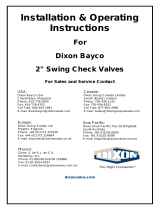 Dixon Bayco 3020 Series User manual
Dixon Bayco 3020 Series User manual
-
 Dixon Bayco FT451 Ground Bolt User manual
Dixon Bayco FT451 Ground Bolt User manual
-
 Dixon FloTech Sensor Tube Cutting Operating instructions
Dixon FloTech Sensor Tube Cutting Operating instructions
-
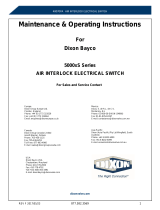 Dixon 5000xS Series User manual
Dixon 5000xS Series User manual
-
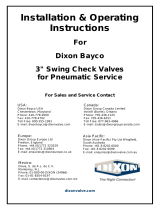 Dixon High Flow 3" 3030 Series Swing Check Valves - Dry Bulk User manual
Dixon High Flow 3" 3030 Series Swing Check Valves - Dry Bulk User manual
-
 Dixon 4040-Series 4" High Flow Swing Check Valves User manual
Dixon 4040-Series 4" High Flow Swing Check Valves User manual
-
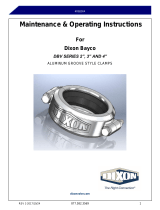 Dixon DBV-Series Aluminum Groove Style Clamps User manual
Dixon DBV-Series Aluminum Groove Style Clamps User manual
-
 Dixon 6000AS Elbow Arm Locking Ring (6000ASR) - Petroleum User manual
Dixon 6000AS Elbow Arm Locking Ring (6000ASR) - Petroleum User manual
-
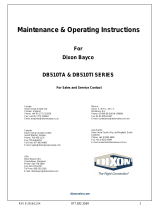 Dixon DB510TA and DB510TI Series Drop Tees User manual
Dixon DB510TA and DB510TI Series Drop Tees User manual
-
 Dixon Compact Sight Glass Seal Change User manual
Dixon Compact Sight Glass Seal Change User manual

















